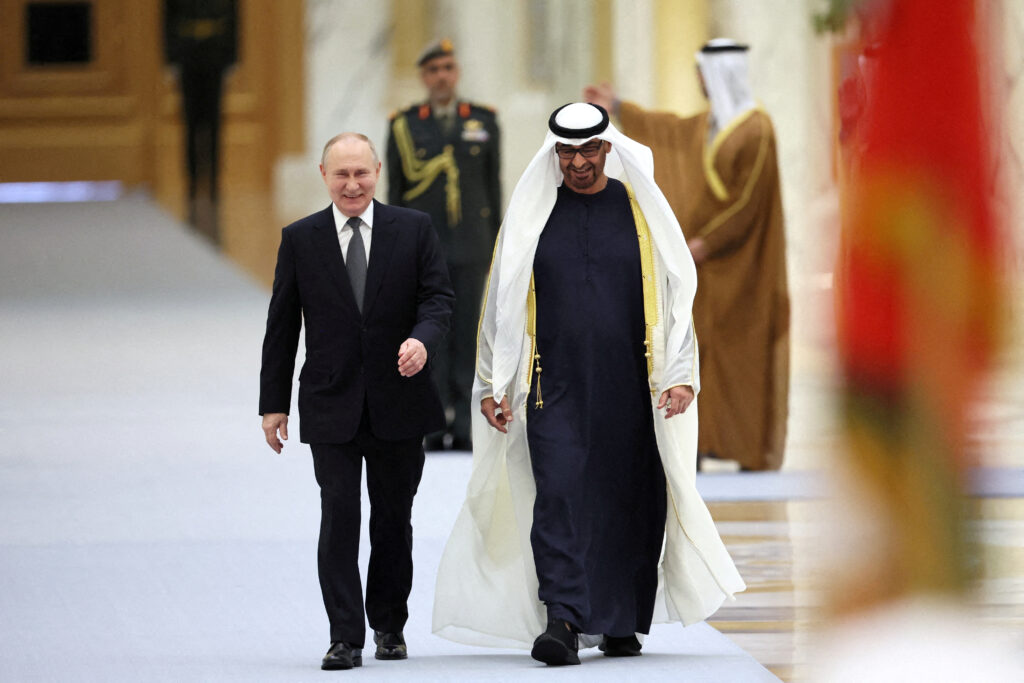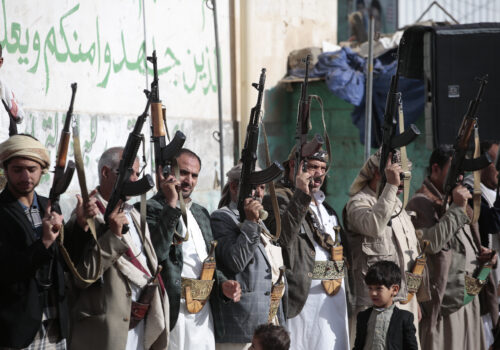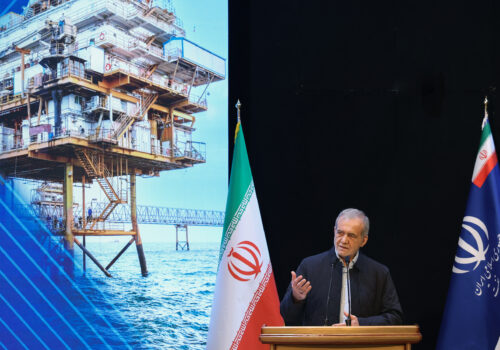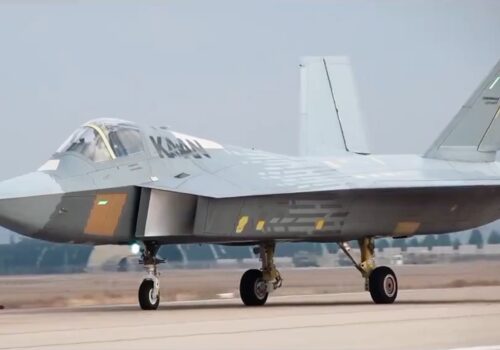Last February, Russian defense companies showcased their latest products at IDEX, the arms fair convened by the United Arab Emirates every two years. Among other things, Rostec, the Russian public conglomerate, displayed its Supercam S350 multipurpose drone, which reportedly took down numerous Western unmanned systems deployed on Ukrainian battlefields since Moscow’s 2022 invasion there.
Historically, Russia has never been a major player in the Gulf defense market. Due to their security arrangements and the associated operational demands, Gulf armed forces remain heavily anchored in the Western orbit. As a result, their rulers procure most of their platforms from the United States, the United Kingdom, or France.
However, the high visibility of Moscow’s arms manufacturers at the event in Abu Dhabi fueled speculation among policy pundits and industry watchers that Russia’s defense industry might be on the brink of a breakthrough in the Arabian Peninsula. At first glance, the geopolitical landscape appears favorable. It would follow Washington’s push under President Donald Trump’s administration for an end to the Ukraine war and, as a result, the potential lifting of economic sanctions against the Russian economy.
From the Gulf standpoint, the Russia-Ukraine war was always a Western issue that did not impact their security interests. Countries like Saudi Arabia and the UAE carefully avoided Western sanctions on Russia and maintained a neutral position similar to India’s. This led many Russian businesses to relocate to Dubai to escape international sanctions or military conscription. It also allowed Riyadh to convene several negotiations between Washington, Kyiv, and Moscow. Under those circumstances, as prospects for de-escalation grow, Riyadh and Abu Dhabi could also be tempted to turn to Russian companies for arms transfers.
Such speculations are not new: Saudi Arabia contemplated procuring the S-400 air defense system a decade ago. In 2017, the UAE announced, during another IDEX meeting, that it would jointly develop a fighter jet with Russia’s Rostec. At that time, Russia held a prestigious image among the leaders of the Gulf Cooperation Council. Gulf militaries studied Russia’s “hybrid” strategy in the 2014 Crimea annexation as a textbook operation. A year later, the Russian air campaign in support of the now-ousted Syrian ruler Bashar al-Assad embodied the bold and decisive move to defend a Middle Eastern ally that Gulf leaders bitterly expected from the United States. In that context, Russia was seen in the Gulf as a strong global power and a credible option to diversify Gulf defense procurement away from Washington. Notably, around that same time, Washington’s NATO ally Turkey was also on its way to procure the S-400 system.
Even so, none of those prospects materialized into concrete military cooperation between Russia and the Gulf states. Riyadh never bought the S-400, and the Russian Emirati project of a joint fighter jet merely disappeared from the radar.
Today, the context is even less favorable for the Russian defense industry than it was a decade ago. The Ukraine war eroded the positive perception that Russian companies might have enjoyed back then. From the Gulf perspective, the issue is not about Russia’s motivation for its invasion of Ukraine but about the poor performance of its armed forces on the battlefield. Indeed, the prestige that Crimea garnered in 2014 or the Syrian air campaign in 2015 is gone. This is true, especially in three domains that are closely monitored by Gulf decision-makers: firepower, air operations, and cyber defense.
SIGN UP FOR THIS WEEK IN THE MIDEAST NEWSLETTER
By the fall of 2022, six months into the conflict, Russia had depleted 60 percent of its precision-missile arsenal. Not only was the result on the battlefield inconclusive, but the Russian industry has also struggled to resupply the armed forces. The Russian air force, which looked indomitable during the 2015 intervention in Syria, has displayed an inability to decisively support ground troops in making breakthroughs against Ukrainian soldiers. According to the 2025 International Institute for Strategic Studies Military Balance, by the end of 2024, Russia had “lost at least thirty-one Sukhoi Su-34 Fullback fighter ground-attack aircraft out of a pre-war strength of 124 aircraft”.
Meanwhile, while Russia’s information campaign during the 2014 operation in Crimea was pivotal in ensuring the swift takeover of the region, cyberattacks this time have had a limited strategic impact. Ukraine proved to be better prepared to detect them and also able to launch its own cyberattacks against Russia.
Even the prestige of Russia’s S-400, arguably one of the most advanced systems in the world of air defense, has suffered. Several times, Ukraine has been able to destroy S-400 batteries using its fleet of missiles and drones. It is worth noting that in one case, Ukrainians did so with ATACMS, United States-made ballistic missiles that have been in service for the past forty years.
Admittedly, Russian forces did adapt amid the initial setbacks on the battlefield. But their endurance appears to be more an effect of mass—the sheer volume of Russian troops—than their tactical prowess. Furthermore, Russia compensated for its shortcomings in firepower by turning to Iran for resupplies. As a result, Russian air attacks on Ukraine in the past two years have used Iranian ballistic missiles and UAVs. Moscow’s increased reliance on the Islamic Republic demonstrates the diminished prestige of its defense industry. It is unlikely that Gulf states will be convinced to turn to Moscow in this sector.
In addition to the consequences of this poor performance, the Russian defense industry will struggle to remain competitive in the Gulf due to various pressures on its supply chain. First, the Ukraine war remains the focus of the Russian war economy, and its defense companies have been urged to prioritize the troops’ needs. This means their ability to develop and produce supplies for international partners is severely reduced. Such demands on the Russian defense industry are also compounded by Western economic sanctions that constrain Moscow’s access to some subcomponents of its systems and complicate the ability of companies to produce.
At the global level, those factors explain the severe reduction in Russia’s arms exports in the past five years. Russia, a traditional major player in the global defense market, saw its arms exports drop by 64 percent in the past five years. For instance, Russian industries have struggled to deliver supplies ordered by India, one of its traditional clients. Russia remains the primary supplier of the Indian Armed Forces. However, while Moscow supplied 55 percent of India’s arms imports between 2015 and 2019, this share fell to 36 percent between 2020 and 2024. The government of Prime Minister Narendra Modi might not change its diplomatic stance regarding the Ukraine war, but it is already turning to other suppliers (primarily France, Israel, and the United States) for its armed forces. Given the close ties between India and the Gulf states, this is certainly something that the UAE or Saudi Arabia is taking stock of.
Eventually, this underlines the gap between Gulf political statements on Russia and the reality of their limited military cooperation with Moscow. The high visibility of Russian arms producers in Gulf defense events like IDEX might suggest otherwise. But time and time again, Gulf states have contemplated procuring Moscow’s platforms before backtracking themselves. This is unlikely to change, no matter what happens with the ongoing negotiations over the Ukraine war.
Jean-Loup Samaan is a senior nonresident senior fellow at the Atlantic Council‘s Scowcroft Middle East Initiative and a research fellow at the Middle East Institute of the National University of Singapore.
Further reading
Fri, Mar 14, 2025
The United States’ Houthi terrorist designation unmasks Russia’s Yemen strategy
MENASource By
Yemen's Houthi rebels have become a tool of foreign powers, shifting from an Iran proxy to a Russian asset.
Wed, Apr 23, 2025
Gas diplomacy: A blueprint for Middle East peace and global energy security
MENASource By
A US-Iran deal could serve as a turning point towards a wider strategy encompassing regional de-escalation and energy diplomacy.
Sat, Jan 18, 2025
Why Saudi Arabia is so keen on the Turkish KAAN
MENASource By Ali Bakir
With Saudi Arabia previously keen on acquiring F-35 fighter jets from the United States, what has steered Riyadh toward Turkish technology?
Image: President of the United Arab Emirates Sheikh Mohamed bin Zayed Al Nahyan and Russian President Vladimir Putin walk during a meeting at Qasr Al Watan in Abu Dhabi, United Arab Emirates December 6, 2023. Sputnik/Sergei Savostyanov/Pool via REUTERS ATTENTION EDITORS - THIS IMAGE WAS PROVIDED BY A THIRD PARTY.




